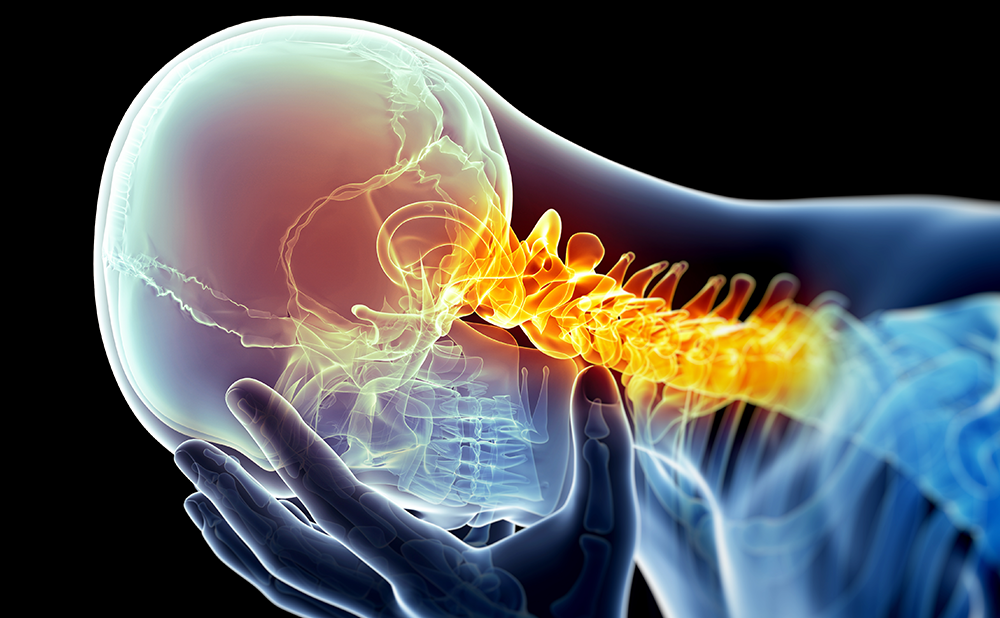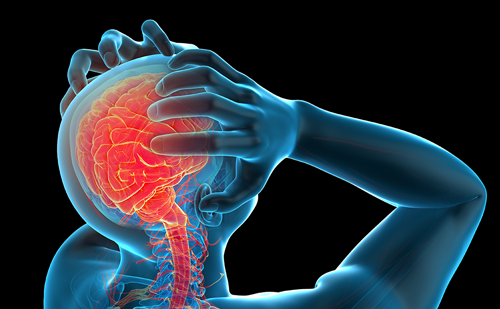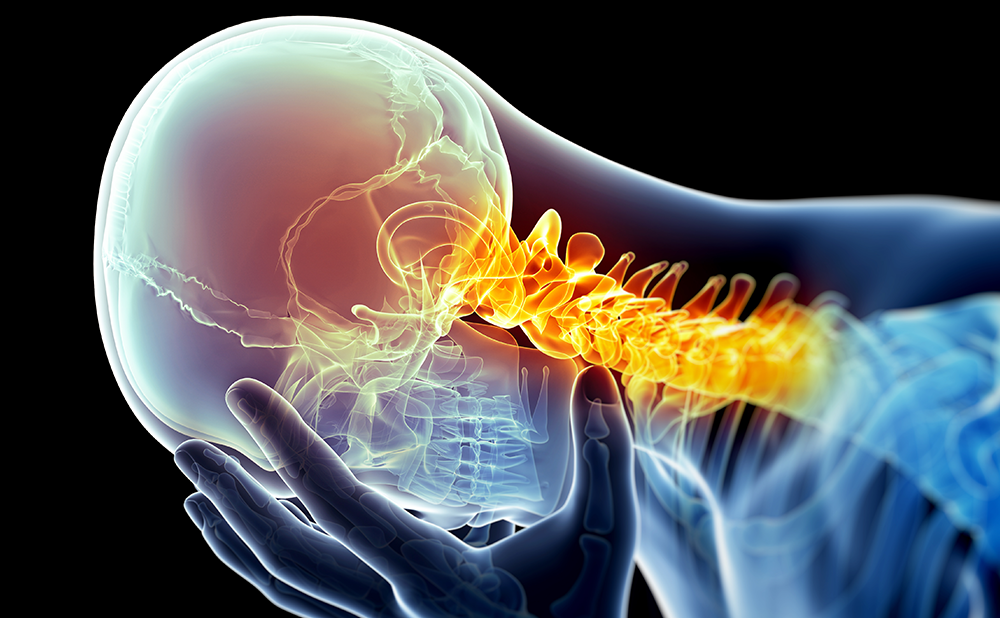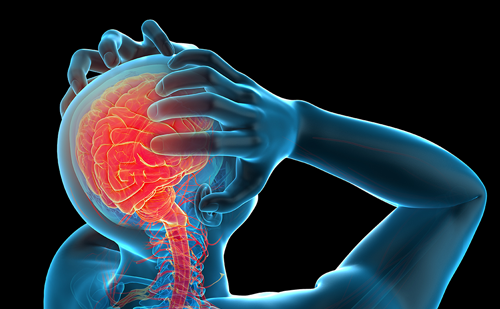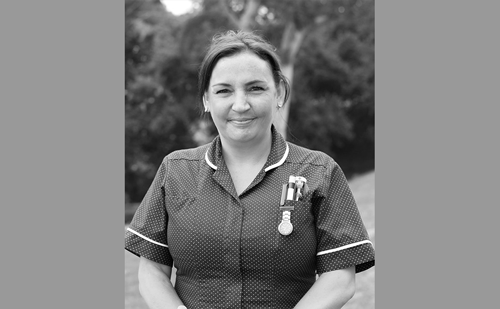Tension-type headache (TTH) is the most prevalent headache type and the one with the highest socioeconomic costs.1 It is a complex disorder in which a range of heterogeneous mechanisms are likely to play a role.2 The treatment of an acute episode in patients with infrequent TTH is often straightforward. However, in patients with frequent headaches, biological mechanisms – in particular increased sensitivity of the central nervous system3 – and psychological mechanisms often complicate treatment. It is important to consider which mechanisms may be important for the individual patient and to tailor the treatment accordingly.
The diagnostic problem most often encountered is the difficulty of discriminating between TTH and mild migraines. Measures towards attaining a correct diagnosis include keeping a headache diary4 over at least four weeks. The diary may also reveal triggers and medication overuse, and it will establish the baseline against which to measure the efficacy of treatments. Identification of a high intake of analgesics is essential as other treatments are largely ineffective in the presence of medication overuse.5 Significant co-morbidity, e.g. anxiety or depression, should be identified and treated concomitantly. It should be explained to the patient that frequent TTH can only rarely be cured, but that a meaningful improvement can be obtained with the combination of non-drug and drug treatments. These treatments are described separately in the following article, but should go hand in hand.
Non-pharmacological Management
Information, Reassurance and Identification of Trigger Factors
Non-drug management is widely used and should be considered for all patients with TTH. However, the scientific evidence for the efficacy of most treatment modalities is sparse. The fact that the physician is concerned about the problem may have a therapeutic effect, particularly if the patient is troubled about serious disease, e.g. brain tumour, and can be reassured by a thorough examination. A detailed analysis of trigger factors should be performed, since avoidance of trigger factors may have a long-lasting effect. The most frequently reported triggers for TTH are stress (mental or physical), irregular or inappropriate meals, high intake of coffee and other caffeine-containing drinks, dehydration, sleep disorders, too much or too little sleep, reduced or inappropriate physical exercise, psychological problems, variations during the female menstrual cycle and hormonal substitution.6,7 Most triggers are self-reported and so far none of the triggers has been systematically tested.
Information about the nature of the disease is important. It can be explained that muscle pain may lead to a disturbance of the brain’s pain-modulating mechanisms,3,8 so that normally innocuous stimuli are perceived as painful, with secondary perpetuation of muscle pain and risk of anxiety and depression. Moreover, it should be made clear to the patient that the prognosis in the longer run is favourable, since approximately half of all individuals with frequent or chronic TTH experienced remission of their headaches in a 12-year epidemiological follow-up study.9
Psychological Treatments
A large number of psychological treatment strategies have been used to treat TTH. Three strategies have reached reasonable scientific support for effectiveness10 and will be described.
Relaxation Training
The goal of relaxation training is to help the patient to recognise and control tension as it arises in the course of daily activities. During the training, the patient sequentially tenses and then releases specific groups of muscles throughout the body. Advanced stages involve relaxation by recall, association of relaxation with a cue word and maintaining relaxation in muscles not needed for the activity currently engaged in.10
Electromyography Biofeedback
The aim of electromyography (EMG) biofeedback is to help the patient to recognise and control muscle tension by providing continuous feedback about muscle activity. Sessions typically include an adaptation phase, a baseline phase, a training phase – where feedback is provided – and a self-control phase – where the patient practises controlling muscle tension without the aid of feedback.10
Cognitive–Behavioural Therapy
The aim of cognitive–behavioural therapy is to teach the patient to identify thoughts and beliefs that generate stress and aggravate headaches.11 These thoughts are then challenged, and alternative adaptive coping self-instructions are considered. A variety of exercises may be used to challenge thoughts and beliefs, including experimenting with the adoption of another person’s view of the situation, actively generating other possible views of a situation and devising a behavioural experiment to test the validity of a particular belief.10
Meta-analyses have concluded that the treatments described above reduce headache by 37–50%, with no significant difference among treatments.12 However, the exact degree of effect is difficult to estimate because of methodological difficulties of designing appropriate placebo procedures. The most useful information on efficacy derives from a study by Holroyd et al.13 demonstrating similar improvements in patients with chronic TTH by cognitive–behavioural therapy, treatment with tricyclic antidepressants and a combination of the two treatments. All three treatment strategies reduced the headache index by approximately 30% more than placebo after six months. Patients who received the combination of the two treatments were more likely to show substantial reductions in TTH than patients who received either treatment alone.
Although the psychological treatments seem to have similar efficacy in controlled trials, this is unlikely to be the case for the individual patient. Psychological treatments are relatively time-consuming, and unfortunately there are no documented guidelines about the psychological treatment(s) to choose for the individual patient. Therefore, until scientific evidence is provided, common sense must be used. Thus, it is likely that cognitive–behavioural therapy will be most beneficial for the patient in whom psychological problems or affective distress play a major role, while biofeedback or relaxation training may be preferable for the tense patient.
Physical Therapy
Physical therapy is the most used non-pharmacological treatment of TTH and includes the improvement of posture, relaxation, exercise programmes, hot and cold packs, ultrasound and electrical stimulation, but the majority of these modalities have not been properly evaluated.14 Active treatment strategies are generally recommended.14 A controlled study15 combined various techniques such as massage, relaxation and home-based exercises and found a modest effect. It was recently reported that adding craniocervical training to classic physiotherapy was better than physiotherapy alone.16 A recent study found no significant long-lasting differences in efficacy between relaxation and physical training and acupuncture.17 Furthermore, spinal manipulation has no effect for the treatment of episodic TTH.18 Oromandibular treatment with occlusal splints is often recommended, but has not yet been tested in trials of reasonable quality and cannot be generally recommended.19
It can be concluded that there is a huge contrast between the widespread use of physical therapies and a lack of robust scientific evidence for the efficacy of these therapies. Further studies of improved quality are necessary to either support or refute the effectiveness of physical modalities in TTH.20,21
Acupuncture and Nerve Block
There are conflicting results regarding the efficacy of acupuncture for the treatment of TTH. A recent large trial found acupuncture to be better than no treatment but not superior to minimal acupuncture,22 while another recent trial23 found no significant effect of traditional Chinese acupuncture over sham puncture on the primary efficacy parameter, while secondary efficacy parameters indicated a modest effect of traditional acupuncture. Recently, laser acupuncture has been reported as effective,24 while acupuncture-like electrical stimulation was not effective.25 A recent study reported no effect of greater occipital nerve block in patients with chronic TTH.26
Pharmacological Management
Acute drug therapy refers to the treatment of individual attacks of headache in patients with episodic and chronic TTH. Most headaches in patients with episodic TTH are mild to moderate and the patients can often self-manage by using simple analgesics. The efficacy of simple analgesics tends to decrease with increasing frequency of the headaches. In patients with chronic TTH, the headaches are often associated with stress, anxiety and depression. Simple analgesics are usually ineffective, and should be used with caution because of the risk of medication-overuse headache at a regular intake of simple analgesics (over 14 days a month), or of triptans or combination analgesics for more than nine days a month.27 Other interventions such as non-drug treatments and prophylactic pharmacotherapy should be considered. The following discussion on acute drug therapy mainly addresses the treatment of patients with episodic TTH, while the discussion on prophylactic drug therapy addresses the treatment of chronic TTH.
Acute Pharmacotherapy
Simple Analgesics
Most randomised, placebo-controlled trials have demonstrated that aspirin in doses of 500 and 1,000mg28 and acetaminophen 1,000mg28,29 are effective in the acute therapy of TTH. One study found no difference in efficacy between solid and effervescent aspirin.30 There is no consistent difference in efficacy between aspirin and acetaminophen. The non-steroidal anti-inflammatory drugs (NSAIDs) – ibuprofen 200–400mg, naproxen sodium 375–550mg, ketoprofen 25–50mg and diclofenac potassium 50–100mg – have all been demonstrated to be more effective than placebo in acute TTH.31,32 Most, but not all, comparative studies report that the above-mentioned NSAIDs are more effective than acetaminophen and aspirin.31,32 Although simple analgesics are effective in episodic TTH, the degree of efficacy has to be put in perspective. For example, the proportion of patients who were pain-free two hours after treatment with acetaminophen 1,000mg, naproxen 375mg and placebo were 37, 32 and 26%, respectively.29 Thus, efficacy is modest and clearly there is room for better acute treatment of episodic TTH.
Combination Analgesics
The efficacy of simple analgesics is increased by combination with caffeine 64–200mg.31,33 There are no comparative studies examining the efficacy of combination with codeine. Generally, combination analgesics cannot be recommended because of the increased risk of medication-overuse headache.
Triptans and Muscle Relaxants
Triptans have been reported to be effective for the treatment of interval headaches in patients with migraine,34 which were most likely mild migraines,35 but triptans do not have a clinically relevant effect in patients with episodic TTH.36 Muscle relaxants have not been demonstrated to be effective in episodic TTH.
Conclusions
Simple analgesics are the mainstays in the acute therapy of TTH (see Table 1). Acetaminophen 1,000mg may be recommended as the drug of first choice because of a better gastric side-effect profile.37 If acetaminophen is not effective, ibuprofen 400mg may be recommended because of a favourable gastrointestinal side-effect profile compared with other NSAIDs.37 Physicians should be aware of the risk of developing medication-overuse headache as a result of frequent and excessive use of analgesics in acute therapy.5 Triptans, muscle relaxants and opioids do not have a role in the treatment of TTH.
Prophylactic Pharmacotherapy
Prophylactic pharmacotherapy should be considered in patients with headaches for more than 15 days per month, i.e. in patients with chronic TTH. For many years the tricyclic antidepressant amitriptyline has been used. Recently, other antidepressants, NSAIDs, muscle relaxants, anticonvulsants and botulinum toxin have been tested in chronic TTH.
Amitriptyline
Amitriptyline, a tricyclic antidepressant, is the only drug that has been proved to be effective in several controlled trials in TTH. Thus, five out of six placebo-controlled studies found a significant effect of amitriptyline.38 The two most recent studies reported that amitriptyline 75mg/day reduced the headache index (duration x intensity) by 30% compared with placebo.13,39 The effect was long-lasting (at least six months)13 and not related to the presence of depression.39 It is important that patients are not only informed that this is an antidepressant agent, but also that it has an independent action on pain. Amitriptyline should be started at low dosages (10mg/day) and titrated by 10mg weekly, until the patient has either good therapeutic effect or side effects are encountered. The maintenance dose is usually 30–70mg daily administered one to two hours before bedtime to help to circumvent any sedative adverse effects. A significant effect of amitriptyline may be observed as early as the first week on the therapeutic dose.39 Therefore, it is advisable to change to another prophylactic therapy if the patient does not respond after three to four weeks on maintenance dose. The side effects of amitriptyline include dry mouth, drowsiness, dizziness, obstipation and weight gain. Dry mouth was observed in 75% and drowsiness in 53% of chronic TTH patients.39 Discontinuation should be attempted every six to 12 months.
Other Antidepressants
The tricyclic antidepressant clomipramine and the tetracyclic antidepressants maprotiline and mianserin have been reported to be more effective than placebo, while the selective serotonin re-uptake inhibitors (SSRIs) have not been found to be effective.38 Interestingly, antidepressants with action on both serotonin and noradrenaline seem to be as effective as amitriptyline, with the advantage that they are tolerated at the doses needed for the treatment of a concomitant depression. Thus, the noradrenergic and specific serotonergic antidepressant mirtazapine 30mg/day reduced the headache index by 34% more than placebo in difficult-to-treat patients, including patients who had not responded to amitriptyline.40 The serotonin and noradrenaline re-uptake inhibitor venlafaxine (150mg/day)41 reduced headache days from 15 to 12 per month. However, the latter study is difficult to compare with the other studies mentioned because it was a small parallel-group study performed in a mixed group of patients with either frequent episodic or chronic TTH.
A recent study demonstrated that low-dose mirtazapine 4.5mg/day alone or in combination with ibuprofen 400mg/day was not effective in treating chronic TTH. Interestingly, ibuprofen alone increased headache, indicating a possible early onset of medication-overuse headache.42
Miscellaneous Agents
A recent open study reported an effect of the anticonvulsant topiramate 100mg/day.43 Currently, tizanidine, botulinum toxin, propranolol or valproic acid cannot be recommended for the prophylactic treatment of TTH.38
Conclusions
In general, the initial approach to prophylactic pharmacotherapy of chronic TTH is through the use of amitriptyline (see Table 1). Concomitant use of daily analgesics should be avoided. If the patient does not respond to amitriptyline, mirtazapine could be attempted. Venlafaxine or SSRIs could be considered in patients with concomitant depression if tricyclics or mirtazapine are not tolerated. The physician should keep in mind that the efficacy of preventative drug therapy in TTH is often modest, and that the efficacy should outweigh the side effects. More efficient prophylactic drugs with fewer side effects are urgently needed for the preventative treatment of TTH.
As neither non-pharmacological nor pharmacological management is highly efficient, it is usually recommended to combine multiple strategies, although proper evidence is lacking. Therefore, it is reassuring that the first study that has evaluated the efficacy of a multidisciplinary headache clinic has reported positive results.44 Treatment results for all patients discharged within one year were evaluated. Patients with episodic TTH demonstrated a 50% reduction in frequency, a 75% reduction in intensity and a 33% absence rate, whereas chronic TTH patients responded with 32, 30 and 40% reductions, respectively.44
Conclusion
TTH is a common primary headache with tremendous socioeconomic impact. The establishment of an accurate diagnosis is important before the initiation of any treatment. Non-pharmacological management is crucial. Information, reassurance and identification of trigger factors may be rewarding. Psychological treatments with scientific evidence for efficacy include relaxation training, EMG biofeedback and cognitive–behavioural therapy. Physical therapy and acupuncture are widely used, but the scientific evidence of efficacy is sparse. Simple analgesics are the mainstays for treatment of episodic TTH. Combination analgesics, triptans, muscle relaxants and opioids should not be used, and it is crucial to avoid frequent and excessive use of simple analgesics to prevent the development of medication-overuse headache. The tricyclic antidepressant amitriptyline is the drug of first choice for the prophylactic treatment of chronic TTH. The efficacy is modest, and treatment is often hampered by side effects. Thus, treatment of frequent TTH is often difficult and multidisciplinary treatment strategies can be useful. The development of specific non-pharmacological and pharmacological managements for TTH with higher efficacy and fewer side effects is urgently needed. Future studies should also examine the relative efficacy of the various treatment modalities, e.g. psychological, physical and pharmacological treatments, and clarify how treatment programmes should be optimised to best suit the patient. ■


